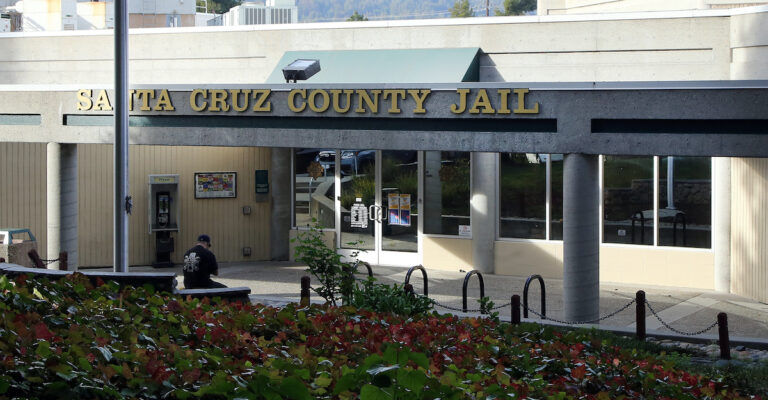There were four more requests for gun violence restraining orders on Jeff Brooker’s desk when he arrived at the San Diego City Attorney’s Office that July morning.
Officers had responded to a minor car crash at a mall where the driver, who carried a replica firearm, was rambling delusionally and threatening to kill the “one-percenters” and a public official. Another man, during an argument outside a family member’s home, had pulled a gun out of his waistband and pointed it at someone’s head as several others looked on.
It was not an unusual number of new cases for the department’s eight-member gun violence restraining order unit, which Brooker oversees. In an average week, they triage 30 referrals from local police, reviewing scenarios in which officers believe a resident is at risk of committing gun violence.
About a third of the time — in those instances when the person clearly poses a danger to themselves or others, and they aren’t already prohibited from possessing weapons for another reason — the office will petition a judge to temporarily seize their firearms, under a six-year-old California statute that was among the country’s first “red flag” laws.
More than 1,250 times since the end of 2017, when San Diego City Attorney Mara Elliottlaunched the pioneering unit, Brooker’s team has successfully filed a gun violence restraining order, leading to the seizure, as of April, of nearly 1,600 firearms from 865 people — far more than any other agency in the state. An estimated one-third of the weapons, most of which are handguns, have since been returned to the owners.
“Do you believe this person should have a gun? Your own sense is the best test,” said Brooker, who employs a cable television thought experiment to illustrate how he tries to depoliticize the highly charged red flag law: If a case hypothetically turns into a major news story, how might it be covered by both liberal MSNBC host Rachel Maddow and conservative Fox News anchor Sean Hannity?
“If this is a case they can agree on, this is the kind of case we’re going to file,” Brooker said.
These red flag laws, touted by advocates as one of the best tools available to prevent gun violence, received a renewed push this summer after a mass shooting at an elementary school in Uvalde, Texas, left 19 students and two teachers dead.
Congress responded by passing rare gun safety legislation, with bipartisan support, that could provide hundreds of millions of dollars to help states adopt or expand their own red flag laws. Nineteen states and the District of Columbia already have laws, but a recent analysis by the Associated Press found that many of those are barely used.
In California, which ranked seventh in number of cases per capita, San Diego has been a model.
With many jurisdictions still slow to adopt the use of gun violence restraining orders, the Governor’s Office of Emergency Services announced in July that it would provide $1 million to the San Diego City Attorney’s Office to expand its training efforts to other law enforcement groups.
“We must work together to make sure our gun safety and red flag laws are being used to protect our communities. They’re being underutilized,” Attorney General Rob Bonta said at a joint press conference with Elliott last month. “Others should take San Diego’s lead — be aggressive, use the tool that is there.”
A Pioneering Program
While the California law allows police, close family members, housemates, employers, co-workers and school officials to seek a gun violence restraining order for someone they believe poses a danger to themselves or others, nearly all cases in the state are initiated by law enforcement. Assembly Bill 2870, now before Gov. Gavin Newsom, would expand the list of eligible petitioners to include more family members and people who are dating or share children with the gun owner.
A judge can immediately order the person to relinquish their guns and declare them ineligible to purchase firearms and ammunition for three weeks or, after a hearing, extend the ban to as long as five years. The person can then petition once a year to lift the order and have their weapons returned.
Under Elliott, San Diego has invested in its red flag program like nowhere else in California, with close coordination between the city attorney’s office and the police department to streamline the process for obtaining an order. Brooker’s team includes three attorneys, a paralegal, a legal secretary, a police officer and two retired police officers who work part-time as investigators, preparing cases for review.
Petitions for orders arrive around the clock, Brooker said. While police can obtain an emergency order directly from a judge to take someone’s firearms for 21 days, the city attorney’s office steps in to decide whether to pursue a longer-term seizure of a year or more. Brooker’s team is in court every morning filing paperwork and conducting hearings for new cases or existing orders that are expiring.
The investigators had already been in for several hours when Brooker arrived at their fifth-floor office, overlooking Civic Center Plaza in downtown San Diego. Informational packets were ready for several new petitions that had come in overnight.
Brooker’s corner office overflows with “Star Wars” memorabilia, including a signed poster of Princess Leia and an Obi-Wan Kenobi T-shirt sharing a coat rack with his jackets and ties. On his bookshelf, a tome about the original Star Wars trilogy abuts Shakespeare’s collected works and a copy of the Constitution.
His team’s goal is only to remove guns from a situation until it can be made safe, Brooker said, so sometimes they work with a person on a plan to return their firearms, rather than requesting to extend the order.
This is more common for threats of suicide, when the gun violence restraining order can provide someone with time to cool off and stabilize. If drug or alcohol abuse is involved, or if a person seems to have deeper mental disorders, Brooker said his team will likely ask for a longer seizure of their weapons.
“They’re not all bad people or criminals,” he said. “Some of them are just going through a period of crisis.”
Taking a Cautious Approach
The most common types of cases depend on what’s happening in the world. Brooker said that domestic violence, suicide, child abuse, protest threats and social media threats all picked up during the coronavirus pandemic. Around holidays, there are more domestic violence and suicide cases, while after any mass shooting, there are many potential copycats.
“If there was ever a time I was rethinking my life and career, it was in that month after Uvalde,” Brooker said. Schools were going into lockdown every day, graduations were being threatened and his team was out every night executing search warrants for weapons that a judge had ordered removed.
Brooker said he takes a cautious approach to filing cases, because he is concerned about blowback from gun rights advocates. Every petition is investigated by the retired police officers to ensure that the potential threat is not based on unvetted evidence or an old history of violence.
“I know they’re waiting for us to file one bad case so they can jump all over us,” he said. “That’s the case that’s going to bite us.”
Though the red flag law has not encountered widespread resistance in California, it does remain deeply controversial with gun rights activists. Critics argue that the law violates due process rights by allowing a judge to order someone’s firearms removed before they’ve ever had a chance to defend themselves and by requiring that person to go to court to get their weapons back. Groups across the country are eyeing new legal challenges to red flag laws, which have been consistently upheld in court, following a summer Supreme Court ruling that strengthened gun rights.
Sam Paredes, executive director of the advocacy group Gun Owners of California, called the law an “insincere” attempt to deal with gun violence, without dealing with the underlying mental health issues or other dangerous situations.
“We don’t have an issue with trying to deal with people who are identified as a danger to themselves or others. We have an existing procedure to deal with that all the way,” Paredes said. “Gun violence restraining orders or red flag laws are nothing more than a political football that is being thrown around the field.”
Considered in Court
When Brooker and a colleague arrived at the county courthouse at 9 a.m., they were ushered into the courtroom by the bailiff, who informed Brooker that none of his respondents had checked in yet.
“Good, because I’ve got two dismissals and a continuance today,” Brooker replied.
While Superior Court Judge Adelaida Lopez led the parties and witnesses through an oath, Brooker was on his phone, writing notes about how he expected the cases to go and taking another quick read of the files to be prepared for any questions. In between, he checked his email and snuck a peek at a few photos from his son who had just moved to Switzerland for college.
Brooker’s cases were among the first to be heard. In one, a man had told police he was trying to drink himself to death. While he didn’t have any firearms that the officers knew of, they wanted to obtain a gun violence restraining order to prevent the man from legally buying one in a moment of desperation.
Brooker asked for another continuance, giving his office more time to serve the defendant with a notice of the hearing.
“We tried him using soft contacts first for officer safety and obvious reasons, so there is due diligence, I can assure you,” Brooker said.
Lopez granted another 21-day continuance. Then Brooker moved to his next case, where the defendant had also been put under a mental health hold, which would prohibit him from possessing firearms and make a gun violence restraining order unnecessary.
“I think we can take it off the calendar. And will that result in a dismissal?” Lopez said. “Item 32 is dismissed. That protective order is dissolved.”
“Very good. Thank you, Your Honor,” Brooker said. The whole proceeding took less than five minutes.
It’s not always so quick. Brooker said his team once sought an order for an IT worker who was suspected of scoping out the hospital from which he had been fired, setting off fears that he was planning a mass shooting. The man hired high-powered lawyers, and there were five days of witness testimony before the judge ultimately agreed to grant the gun removal order.
Back in the office after court, a colleague informed Brooker that she had received a call from the nearby Carlsbad Police Department. Officers had obtained a gun violence restraining order for a man and served it to him during a vehicle stop, which is considered safer than doing it at home. But the man was refusing to give them the combination to the gun safe in his car, so the officers had detained him.
Brooker told his colleague to send the officers a template for a search warrant. When he checked back in with the Carlsbad police later — each text message to his phone arriving with the sound of Darth Vader breathing — he learned that the officers had ultimately kept the safe and let the man go, while they waited for approval of the search warrant to open it.
“They’re actually treating him well by letting him go, rather than detaining him for hours or even taking him down to jail and booking him,” Brooker said. “The purpose of this is just to get the gun. We’re not trying to put someone in a worse position.”
Slow to Embrace Red Flag Law
Nearly a third of all gun violence restraining orders issued in California last year — 435 out of 1,384 — came from San Diego County, according to data from the Department of Justice. By comparison, Los Angeles County, with three times as many people, had just 54. Two dozen counties reported no orders at all.
The slow and highly regional adoption of California’s red flag law has baffled and frustrated gun safety advocates, who point to research that has found the approach is an effective tool for reducing suicides and preventing mass shootings. Some states that passed red flag laws more recently — particularly Florida, which acted following the 2018 high school shooting in Parkland — quickly surpassed California in their use of the orders.
“I’m mystified,” said Brooker, who blames some combination of a lack of resources and a lack of motivation.
“We live in a society and a day of reaction, not pro-action,” he said. “They don’t want to do it until they have to do it. And usually they have to because there was a shooting and there’s all of the attention on it.”
But as promotion of gun violence restraining orders — and pressure to use the law — has grown, Brooker and his team have become a resource for the entire state. Brooker said people call him from agencies and departments like a customer support line; more than 100 from outside San Diego County have reached out to him for help since January.
Just that morning, he had spoken with the Naval Criminal Investigative Service about filing an order for a San Diego-based sailor who was hospitalized for homicidal and suicidal thoughts. NCIS wanted to remove the man’s firearms now that he was being released from the hospital, but the unit had no jurisdiction to seize the weapons off base.
Brooker’s team also regularly conducts training for law enforcement agencies across the state — the requests always pick up after another mass shooting.
Many officers are intimidated at first, Brooker said. They think they don’t have time to follow all of the steps, or they get lost in the weeds the first few times and it sours them on the law. That’s why he believes a dedicated team like his, which can work hand-in-hand with the local police every day, is critical to success.
“There’s cops that want to do them. There’s cops that try to do them. But if you don’t have support from the command and resources, it’s going to fall short,” Brooker said. “Now there’s weeks I wish they wouldn’t send me so many.”
Yet even as an evangelist for California’s red flag law, Brooker worries that policymakers, through bills like the one currently sitting on Newsom’s desk, are expanding it in counterproductive ways.
He considers it too dangerous for anyone but law enforcement to remove someone’s guns. But a gun violence restraining order that a judge grants a family member or other civil petitioners is served by a process server, giving the recipient 24 to 48 hours to turn in their weapons — and, Brooker fears, retaliate against the petitioner, creating just the sort of shooting that the red flag law is trying to prevent.
“Just call the police,” he said. “I have yet to see one of these filed by a school or a workplace, and I’m grateful for that.”
Spreading the Word
A day earlier, Brooker and his colleagues led a training session for the police department in neighboring National City.
Sgt. Darren Pierson, who runs the department’s training division, thought that if he could get one or two officers to start using gun violence restraining orders, others would see it was not that difficult. He had made the training mandatory for supervisors.
“There needs to be a culture of encouraging it,” Pierson said.
In a large conference room at the Martin Luther King Jr. Community Center, about 30 attendees, some from other local law enforcement agencies, sat at folding tables, filling in from the back like students who hoped the teacher wouldn’t call on them.
The training began with a body camera video of a 2017 case where an officer was shot breaching the house of a man later found to have mental health issues. Brooker wondered aloud if the situation could have been avoided if they had first been able to confiscate the man’s weapons with a gun violence restraining order. The city’s program was not yet in place at the time.
“Could it have stopped something like this hypothetically?” Brooker asked the room. Then over the next several hours, he ran through dozens of scenarios where his team, through trial and error, had found California’s red flag law to be useful.
- A man in the middle of a contentious divorce who, after a confrontation with his estranged wife, threatened to buy a gun and “shoot the bitch” if prosecutors didn’t file domestic violence charges against her. “He’s probably venting, but what if he’s not?” Brooker said.
- A man who posted videos on “dark web” channels practicing shooting tactics and quick reloads from different rooms at the same hotel in downtown San Diego, sparking concerns from the FBI that he was planning a mass shooting. “Looking at that video, did anybody see a crime? Especially because he’s got registered guns,” Brooker said. “Just another way a GVRO can be applied to a case where you may not have another way in, because you do have firearms and you do have danger.”
- A man who regularly dressed as Gandalf, the wizard from “The Lord of the Rings,” and then entered traffic, putting down a staff and declaring, “You shall not pass,” prompting some drivers to beat him up in road rage incidents. Knowing that he owned firearms, police sought a gun violence restraining order so that the man would not be able to potentially fire back.
Brooker argues that the effectiveness of the approach favored by the San Diego City Attorney’s Office is self-evident: 1,600 guns taken off the streets in risky situations where people were “charging hard down” the path to violence but had not necessarily committed a crime.
“Now I see all the cases where the cops’ hands are untied,” he said. “We see fewer cases in the news because of us.”
























